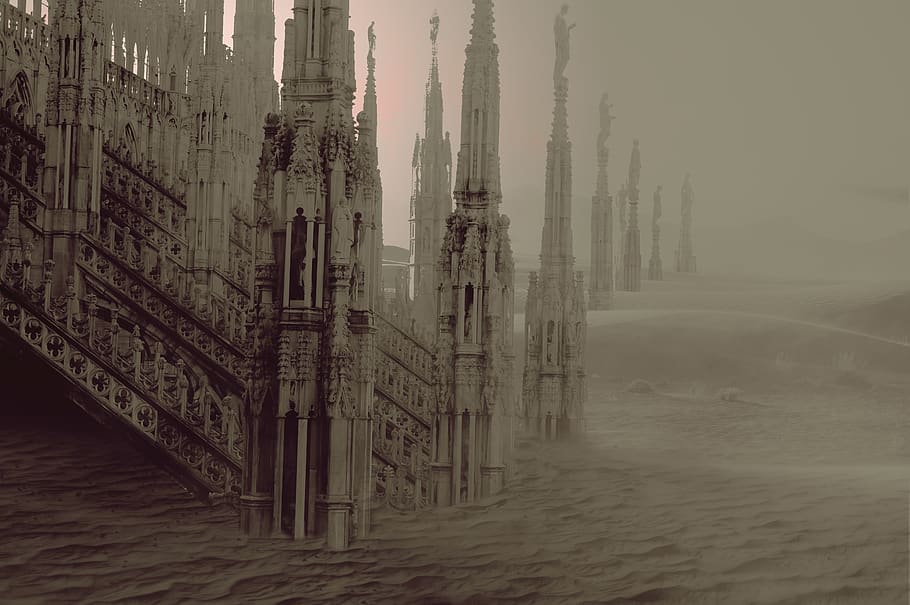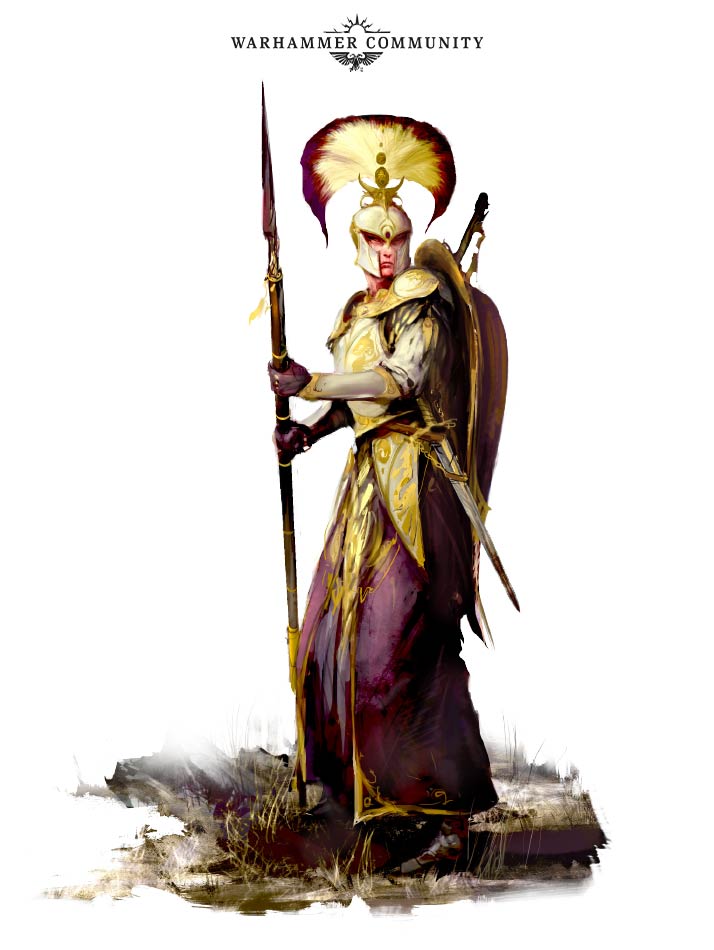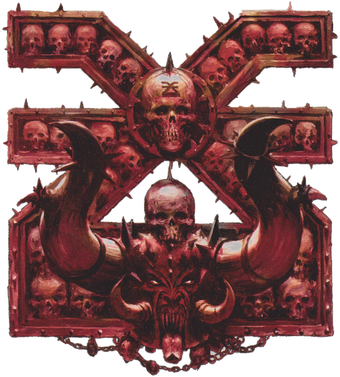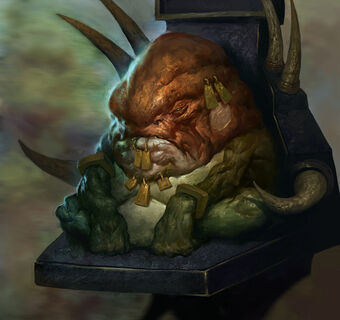The Doom of Pyr Nekheb - A Path to Glory Narrative Campaign
One of the things with our little group is the way our attention doesn't so much flag as it goes veering off down strange corridors. So when we decided to do Path to Glory (for the 15th or 16th time), we made a commitment that we weren't going to get distracted by another army, necessitating a restart. This time, it was going to be a project, with lots of finished miniatures and an unfolding narrative. That way, we'd be more inclined to keep going, as that investment of creativity is more complete. Minimum commitment: two big all day sessions, bracketed by possible smaller sessions. Since we meet once a month, that's two months to build, paint, and plot. Maybe we go another. Maybe we go two!
What follows is the campaign background we've cooked up, both for the setting and the individual warbands. House rules will be up in a separate post, followed by some hobby blogs.
Campaign Background
In the Age of Myth, Pyr Nekheb was a prosperous and industrious city teeming with humanity on the continent of Necros, deep within the Realm of Shyish. Here the Sevenfold Sisterhood drove off the ravaging hordes of Grashnazk the Despoiler, and the alchemists of the True Gold Society made wonders unmatched. Sigmar himself laid the foundation stone of its greatest temple, and Nagash, before his fits of madness, viewed the city beneficently as one of the jewels of his realm.Even in her greatest days, the city saw problems. The machinations of her nobles and priests were a constant source of disruptions, and Pyr Nekheb often warred with her neighbors. Most frightening was the Moon Tithe, a terrifying period lasting months when the goblins and trolls which live in the warrens deep beneath the city would skulk to the surface in order to gather food. The Moon Tithe occurred every 33 years, and the citizens of Pyr Nekheb would leave food outside their doors for the grots, who would, motivated by quite a lot of greed and not a small bit of cowardice, take the food and move on. Those who did not make the proper tithe would be set upon in the night by the greenskins, always at night, always with the interlopers outnumbering the human, elf, or dwarf by three or four to one. Even poor families in the rich city learned that it was better to go hungry a week or two than it was to end up at a goblin feast as the main course.

The undoing of Pyr Nekheb was to be found in its greatest success. In the latter days of the city, her alchemists and sorcerers, with the aid of a colony of Lumineth from the Realm of Light, learned to turn various ores to a wondrous metal which men called Darksilver. This otherwise gloomy alloy glowed with great intensity in the light of the moon, and many wonders were crafted from it.
And so, when the Age of Chaos arrived, warlords and sorcerers alike descended upon the city stripping the treasures within and taking what they pleased. Since that time, the city has lain in ruins, a few of her temples tended by small bands of priests and wayward souls, the lush fields, swamps, and forests outside her ruined walls home to shepherds and farmers too fearful to set foot on her streets.
Yet the descendants of those warlords and sorcerers, powerful and terrible in their own right, still stalk the city. Darksilver can still be found in the darkened alleys and under the fallen eaves of Pyr Nekheb. Tales of arcane machines and hidden realmgates draw many would-be heroes to the largely deserted city. Most are swallowed up by the horrors within; the undead roam the streets, as do some number of foul beastmen or worse creatures of Chaos. And the Moon Tithe still returns every 33 years, only now it is a horde of goblin lunatics, following fell omens to still-hidden stores of food or the few living beings still scrabbling for an existence in the ruins.
Some small number make their fortunes, however. Mabyra Anchorscourge, a down on her luck aelven pirate, sailed up the murky Bottleneck Coast and absconded with the Silvertine Bottle, an artifact which made her enough coin to buy an entire fleet, one which still terrorizes the seas of Shyish. Gardus Greystrike, a powerful paladin of the Stormcast, was made Emissary of the Maelstrom after he took a small warband to liberate ancient statues of Sigmar from a fallen temple in the city’s central square. These tales tantalize, driving the desperate, the brave, and the foolhardy to find similar.
Few do.
His ancestors were workers of Darksilver, some of the Lumineth colonists and smiths who uncovered the secrets of the metal in the Age of Myth, and he bears one of their ancient blades. His forefathers left a dire warning that none of their bloodline should ever set foot in the ruins of the city again, but Valanduil, filled with ambition and hubris, considers that a foolish superstition.
Now Valanduil has found in his studies the location of a small realmgate leading directly from the Realm of Light to the heart of the city. Mustering a small force of aelves, he sets out in search of lost Darksilver and other secrets. Young for one of his kind and dangerously ambitious, this expedition could well be his undoing.
Few do.
Valanduil's Seekers (Lumineth - Peter)
With the Age of Sigmar well underway, a sorcerer and loremaster of the Lumineth has formed a small expedition to reclaim the lost wonders of Pyr Nekheb. Valanduil, Prince and Loremaster of Zaitrec, Holder of the Keys to the Ruby Spire of Nyraxiah, has long coveted the secrets of Pyr Nekheb. Valanduil is a master sorcerer and seeker of forgotten mysteries. From his sanctum, the Ruby Spire, he launches expeditions across the realms through various forgotten or locked realmgates, returning always to his home with treasures and lost lore. Valanduil is accompanied by Syrinc, the fae cat, a strange creature who guards her master fiercely and is often the bearer of good or ill fortune for those around her.His ancestors were workers of Darksilver, some of the Lumineth colonists and smiths who uncovered the secrets of the metal in the Age of Myth, and he bears one of their ancient blades. His forefathers left a dire warning that none of their bloodline should ever set foot in the ruins of the city again, but Valanduil, filled with ambition and hubris, considers that a foolish superstition.
Now Valanduil has found in his studies the location of a small realmgate leading directly from the Realm of Light to the heart of the city. Mustering a small force of aelves, he sets out in search of lost Darksilver and other secrets. Young for one of his kind and dangerously ambitious, this expedition could well be his undoing.

Da Venom Ladz (Gloomspite Gitz - Ian)
The largest tribe of grots in the Pyr Nekheb warrens is the Purple Loon Tribe, a squabbling, fractious, ever hungry collection of backstabbing sub-tribes, factions, clans, and potentates which are unified primarily by the eternal ebb and flow of the Moon Tithe. When it is time to return to the surface, the Purple Loon goblins show a frightening unity of purpose, as thousands of them scour the ruins for food. At the ebb stage, when the goblins are mostly fat and happy, with the Moon Tithe years away, various chiefs who have offended the more powerful of their kind are banished from goblin society in a great game of betrayal and violence.Gibzig Sourshinz is one such goblin chief. He made the mistake of eating one too many bad mushrooms, which lowered his inhibitions enough that he scolded The Slicer of Dem Wot Looks At ‘Im Funny, an immensely powerful and vastly bloated goblin chieftain, for farting during a dinner party. The Slicer had Gibzig and his cousin, Skarnok Cankertongue, escorted from the party, through the tunnels, and turned out on the outskirts of Purple Loon territory.
Gibzig, like all goblins in such predicaments, took to plotting his vengeance. He’s gathered other such exiles and plans a glorious return to respectability via the Moon Tithe. He aims to collect more food and treasures than any other single goblin warlord, exiled or not. In doing so, he’ll be even more powerful than The Slicer, maybe the most powerful goblin in the entire Purple Loon Tribe. For 33 years, at least.
Moloch’s Legion (Blades of Khorne - Scott)
Beyond metals, the smiths of Pyr Nekhab had many other secrets lost to dust and shadow. One such secret was the arcane forge Arthaband, so named for both the circular channel of somber molten metal which once flowed out from it, and the forgotten demon Moloch firing its infernal bellows with rage and hellfire roars.Moloch, the bronze-clad bullheaded demon who had won countless sacrifices, Khorne’s own agent of vengeance with thirty legions of daemon once underneath him. So many skulls taken, so much earth stained wet with blood, and yet somehow, captured by the Lumineth’s mightiest wizards in the Age of Myth. They ripped out his horns and replaced them with a slave crown of Darksilver, forcing him into servitude.
For an age, Moloch was sealed within the forge and his anger grew. The most powerful seal, holding Moloch stationary, faded as the forge’s enchanters - enchanters who were Valanduil’s ancestors - abandoned their posts in the forge to defend the besieged city. The secondary seal, a small circle of enchanted Darksilver itself, lost its power as Valanduil violated his family’s custom, setting foot within Pyr Nekhab. The tertiary seal is all that remains to confine Moloch within the bounds of the city. To break the last seal, Moloch only needs to spill Valanduil’s lifeblood.
Many lives are owed him. Moloch roams the streets with an ever-growing legion of Khornate evil, sating his endless thirst for pain and sacrifice upon the foolish. He is now an instrument of wrath, Khorne’s wrath and his own, upon those who have confined him. With axe, flail and fire, upon dark hoof and aloft by dark wing, Moloch will not stop until the very lords of Shyish drown in more blood and death than they can swallow.

ܟܥ̈ܢܟܥ̈ܢܪ (Kenkenur the resplendent afterthought) (Seraphon - Philip)
There are those who presume the amphibian’s depression of eating, moving, and breathing that follows on a lack of sunlight is akin to death; if the sun is life for the toads and lizards, and the sun should go, then life too should follow. Where there is no presence, there is absence. Surely enough the warmblooded dwellers of the old world found their lives torn asunder by the victory of chaos, and their survival in that cosmic interlude before Sigmar began to reforge the multiverse was nothing short of miraculous--what then could possibly be the word to describe the survival of a race whose sun set still longer ago, whose rocky palisades had sat eclipsed even at the apogee of Karl Franz’s empire? Do we have the language for that word?Such thinkers are remiss and base. Forsooth, there are those to whom the celestial secrets are so intimate that they see beneath the surface view of light as a father, a giver of life, an abstract generative force. No, the sun does not give birth, but stirs awake. And so, if the sun should cease to shine on toads and lizardmen, they do not die, but sleep. Kenkenur is one such seer, and be not surprised that when he sleeps, he dreams.
Kenkenur comes to the Realm of Death in fact to find that sleep more soundly. Long a familiar of the Dracothion, a client of his before he took up his home in the stars, the toad feels a profound pathos when the latter weeps. The alloy of Pyr Nekheb, a tear shed in the Dracothion’s lament for his freedman’s fallen realm, bespeaks a time to mourn, a time to rest, a time to refrain from embracing--a time for such existential repose that Kenkenur can dream more lucidly than ever. He seeks the stone to at last leave off the plaintive constraints of warmblood life and death, all too staccato and poorly executed even in this enlightened juncture, where Nagash and Sigmar race to out-remember their own respective fallen heroes (what could this be but dreaming in bad form?). In this city, he is sure to see and feel his comrades more fervently than ever in his dreams--and in all others’ nightmares.




Comments
Post a Comment